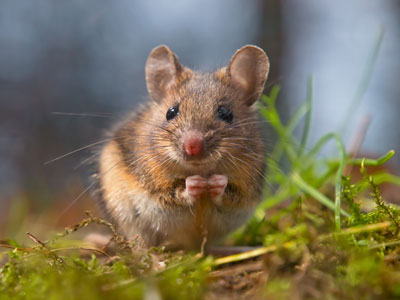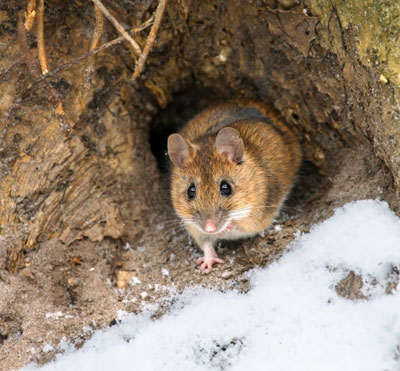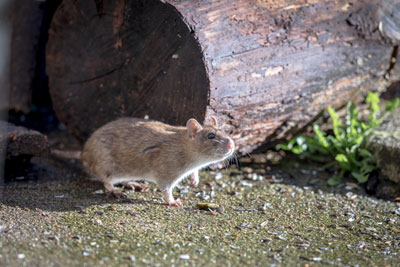




Woodrats are found throughout most of the United States. Wood rats are more commonly called "pack rats" or trade rats because they collect or “pack around” various objects and bits of material to deposit in, or use in, the construction of their nests. Woodrats are especially fond of small, bright, shiny objects, which they will readily confiscate, but bones, cow chips, and bits of wood are all common. When woodrats encounter an interesting object they drop or trade what they are carrying for the new item, consequently the name “trade rat.” There are eight species of woodrats in the U.S. but in Montana we have one, the bushytail woodrat.
Woodrats are about the size of a common Norway rat but the tail is fairly furred and looks like a short-haired squirrel tail. They are also have large protruding ears. Woodrats nest or midden built of plant material like branches, twigs, sticks, and other debris. The huge, beaver-dam-shaped structures may be up to 4 feet across. They may be constructed in a tree or on the ground at the base of a tree, or on rocky ledges but also in your attic, wood shed, or vehicles and machinery that are abandoned or parked for long periods. Woodrats also construct and use latrine areas, which are piles of feces often on a rock or other structure that also contain a smelly sticky black tar like substance. Consequently, their stick nests can be extensive, and the latrine areas and droppings are objectionable. Like other rats the woodrat can carry diseases and ectoparasites.
The woodrat is active year-round, feeding during winter on vegetation stored during the previous fall. Diets vary, but wood rats will eat just about any plant that grows in their territory. Woodrats climb readily and are usually active at night.
Woodrats can become quite a nuisance around homes on the edge of town, vacation homes, cabins, outbuildings, and other infrequently used structures or buildings. They will take up residence in parked farm equipment and vehicles, gnawing on wires and other mechanical components, in addition to stealing treasures for their nests or building large nests in the vehicle or equipment. Woodrats are known to shred upholstered furniture and mattresses for lining nests. Damage to fruit trees, seedlings and saplings due to clipping small twigs and branches and debarking may also occur.
Woodrats can usually be controlled by the use of traps or poison that you would use for other types of rats or mice. Rat snap traps work very well as do many forms of live trap, burrow-entrance traps, or glue boards. However, glue boards are effective only if kept clean as they loose their effectiveness in dusty areas or over long periods. The best baits are peanut butter, oatmeal, nuts, bacon rind, raisins, or dried fruit. Woodrats have little fear of new objects or man-made objects within their territory, which makes them fairly easy to trap. Most rat poisons, while being effective, are dangerous and should be used only under professional supervision. Additionally, most "poisoned" pellet baits should be avoided since rats may carry the pellets to cache in their nest.
There are no registered repellents and none that are considered effective. Fumigants have not proven helpful and shooting has only had limited value. There are some anticoagulants that are registered and must be applied only by a certified applicator.
Woodrats can be permanently excluded from buildings, and this is the most effective method of control. Woodrats are climbers so you must also exclude them from attic or roof level. Pieces of tin, hardware cloth, or chicken wire can be used to seal up any opening along foundations, walls, chimneys, eaves, or roofs. It is important to seal up any openings where pipes, wires, etc., enter buildings. It becomes more difficult to exclude woodrats in vehicles and equipment or even some outbuildings. However, removing the nesting materials and periodically moving the equipment will discourage or deter them, and trapping can eliminate them.
